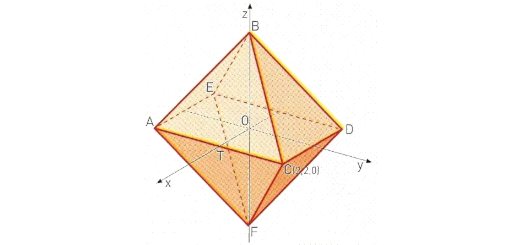Averigue se as funções são idênticas
Funções exponenciais e logarítmicas: Infinito 12 A - Parte 2 Pág. 48 Ex. 22
Em cada uma das alíneas, averigue se as funções $f$ e $g$ são idênticas.
Represente graficamente os pares de funções.
- $f(x)=\log \left( \frac{x}{x-2} \right)$
$g(x)=\log x-\log (x-2)$ - $f(x)=\log \left( x(x-2) \right)$
$g(x)=\log x+\log (x+2)$ - $f(x)=\log {{x}^{2}}$
$g(x)=2\log x$ - $f(x)=\log {{x}^{3}}$
$g(x)=3\log x$ - $f(x)=\log \sqrt{x}$
$g(x)=\frac{1}{2}\log x$
$f(x)=\log \left( \frac{x}{x-2} \right)$
$g(x)=\log x-\log (x-2)$
\[\begin{array}{*{35}{l}}
{{D}_{f}} & = & \left\{ x\in \mathbb{R}:\frac{x}{x-2}>0 \right\} \\
{} & = & \left\{ x\in \mathbb{R}:(x>0\wedge x-2>0)\vee (x<0\wedge x-2<0) \right\} \\
{} & = & \left\{ x\in \mathbb{R}:(x>0\wedge x>2)\vee (x<0\wedge x<2) \right\} \\
{} & = & \left\{ x\in \mathbb{R}:x>2\vee x<0 \right\} \\
{} & = & \left] -\infty ,0 \right[\cup \left] 2,+\infty \right[ \\
\end{array}\]
\[\begin{array}{*{35}{l}}
{{D}_{g}} & = & \left\{ x\in \mathbb{R}:x>0\wedge x-2>0 \right\} \\
{} & = & \left\{ x\in \mathbb{R}:x>0\wedge x>2 \right\} \\
{} & = & \left] 2,+\infty \right[ \\
\end{array}\]
Como ${{D}_{f}}\ne {{D}_{g}}$, então as funções $f$ e $g$ não são idênticas.
Contudo, como \[\log \left( \frac{x}{x-2} \right)=\log x-\log (x-2)\,,\,\forall x\in \left] 2,+\infty \right[\] as funções são idênticas quando se considera $f$ restrita ao domínio de $g$.
$f(x)=\log \left( x(x-2) \right)$
$g(x)=\log x+\log (x+2)$
\[\begin{array}{*{35}{l}}
{{D}_{f}} & = & \left\{ x\in \mathbb{R}:x(x-2)>0 \right\} \\
{} & = & \left\{ x\in \mathbb{R}:(x>0\wedge x-2>0)\vee (x<0\wedge x-2<0) \right\} \\
{} & = & \left\{ x\in \mathbb{R}:(x>0\wedge x>2)\vee (x<0\wedge x<2) \right\} \\
{} & = & \left\{ x\in \mathbb{R}:x>2\vee x<0 \right\} \\
{} & = & \left] -\infty ,0 \right[\cup \left] 2,+\infty \right[ \\
\end{array}\]
\[\begin{array}{*{35}{l}}
{{D}_{g}} & = & \left\{ x\in \mathbb{R}:x>0\wedge x-2>0 \right\} \\
{} & = & \left\{ x\in \mathbb{R}:x>0\wedge x>2 \right\} \\
{} & = & \left] 2,+\infty \right[ \\
\end{array}\]
Como ${{D}_{f}}\ne {{D}_{g}}$, então as funções $f$ e $g$ não são idênticas.
Contudo, como \[\log \left( x(x-2) \right)=\log x+\log (x-2)\,,\,\forall x\in \left] 2,+\infty \right[\] as funções são idênticas quando se considera $f$ restrita ao domínio de $g$.
$f(x)=\log {{x}^{2}}$
$g(x)=2\log x$
\[\begin{array}{*{35}{l}}
{{D}_{f}} & = & \left\{ x\in \mathbb{R}:{{x}^{2}}>0 \right\} \\
{} & = & \mathbb{R}\backslash \left\{ 0 \right\} \\
\end{array}\]
\[\begin{array}{*{35}{l}}
{{D}_{g}} & = & \left\{ x\in \mathbb{R}:x>0 \right\} \\
{} & = & {{\mathbb{R}}^{+}} \\
\end{array}\]
Como ${{D}_{f}}\ne {{D}_{g}}$, então as funções $f$ e $g$ não são idênticas.
Contudo, como \[\log {{x}^{2}}=2\log x\,,\,\forall x\in {{\mathbb{R}}^{+}}\] as funções são idênticas quando se considera $f$ restrita ao domínio de $g$.
$f(x)=\log {{x}^{3}}$
$g(x)=3\log x$
\[\begin{array}{*{35}{l}}
{{D}_{f}} & = & \left\{ x\in \mathbb{R}:{{x}^{3}}>0 \right\} \\
{} & = & {{\mathbb{R}}^{+}} \\
\end{array}\]
\[\begin{array}{*{35}{l}}
{{D}_{g}} & = & \left\{ x\in \mathbb{R}:x>0 \right\} \\
{} & = & {{\mathbb{R}}^{+}} \\
\end{array}\]
As funções $f$ e $g$ são idênticas, pois ${{D}_{f}}={{D}_{g}}={{\mathbb{R}}^{+}}$ e $\log {{x}^{3}}=3\log x\,,\,\forall x\in {{\mathbb{R}}^{+}}\Leftrightarrow f(x)=g(x)\,,\,\forall x\in {{\mathbb{R}}^{+}}$.
$f(x)=\log \sqrt{x}$
$g(x)=\frac{1}{2}\log x$
\[\begin{array}{*{35}{l}}
{{D}_{f}} & = & \left\{ x\in \mathbb{R}:x>0 \right\} \\
{} & = & {{\mathbb{R}}^{+}} \\
\end{array}\]
\[\begin{array}{*{35}{l}}
{{D}_{g}} & = & \left\{ x\in \mathbb{R}:x>0 \right\} \\
{} & = & {{\mathbb{R}}^{+}} \\
\end{array}\]
As funções $f$ e $g$ são idênticas, pois ${{D}_{f}}={{D}_{g}}={{\mathbb{R}}^{+}}$ e $\log \sqrt{x}=\frac{1}{2}\log x\,,\,\forall x\in {{\mathbb{R}}^{+}}\Leftrightarrow f(x)=g(x)\,,\,\forall x\in {{\mathbb{R}}^{+}}$.


















